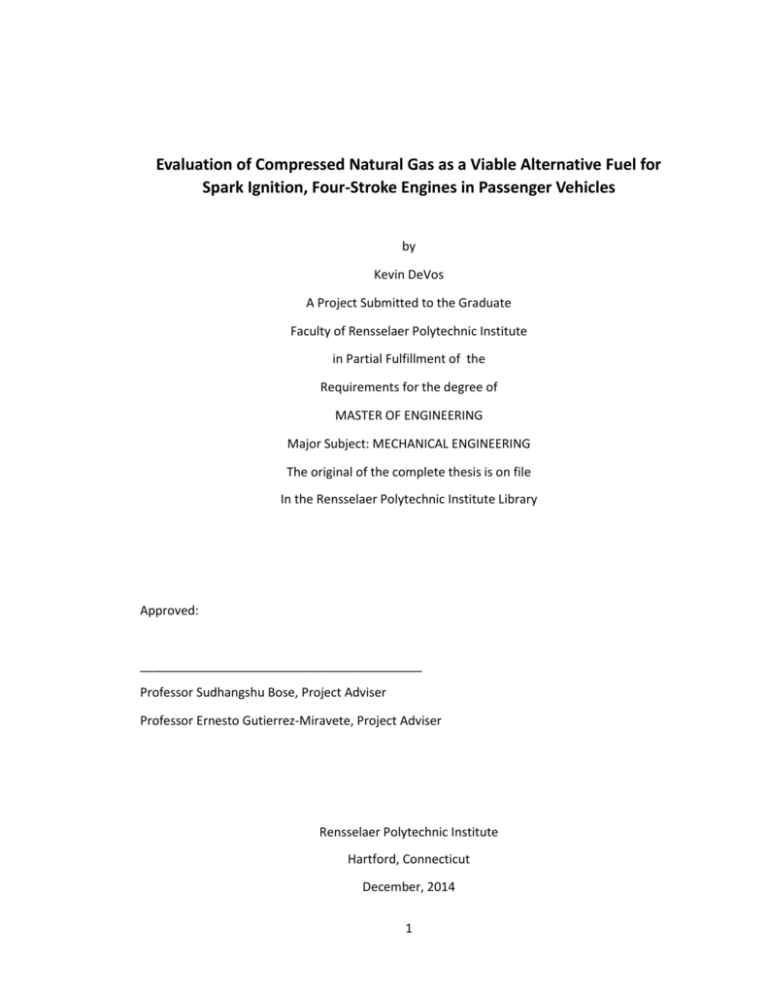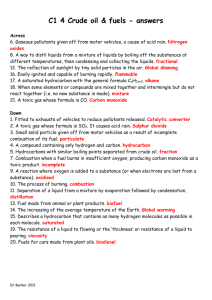
Evaluation of Compressed Natural Gas as a Viable Alternative Fuel for
Spark Ignition, Four-Stroke Engines in Passenger Vehicles
by
Kevin DeVos
A Project Submitted to the Graduate
Faculty of Rensselaer Polytechnic Institute
in Partial Fulfillment of the
Requirements for the degree of
MASTER OF ENGINEERING
Major Subject: MECHANICAL ENGINEERING
The original of the complete thesis is on file
In the Rensselaer Polytechnic Institute Library
Approved:
_________________________________________
Professor Sudhangshu Bose, Project Adviser
Professor Ernesto Gutierrez-Miravete, Project Adviser
Rensselaer Polytechnic Institute
Hartford, Connecticut
December, 2014
1
© Copyright 2014
by
Kevin DeVos
All Rights Reserved
2
CONTENTS
LIST OF TABLES ............................................................................................................................... 4
LIST OF FIGURES.............................................................................................................................. 5
DEFINITIONS ................................................................................................................................... 6
ACRONYMS ..................................................................................................................................... 7
NOMENCLATURE ............................................................................................................................ 8
ACKNOWLEDGMENT ...................................................................................................................... 9
ABSTRACT ..................................................................................................................................... 10
1. Introduction ........................................................................................................................... 11
1.1
Background .................................................................................................................. 11
1.2
Otto Cycle .................................................................................................................... 11
1.3
Problem Statement...................................................................................................... 13
1.4
Previous Work ............................................................................................................. 13
2. Theory .................................................................................................................................... 14
2.1
Second Law of Thermodynamics ................................................................................. 14
3. Methodology .......................................................................................................................... 15
3.1
Overview ...................................................................................................................... 15
3.2
Assumptions ................................................................................................................ 15
3.3
Data Extraction ............................................................................................................ 15
4. Results and Discussion ........................................................................................................... 16
4.1
Problem Table.............................................................................................................. 16
5. Conclusion .............................................................................................................................. 17
6. References.............................................................................................................................. 18
6.1
Works Cited ................................................................................................................. 18
6.2
Additional References Consulted ................................................................................ 19
7. Appendices ............................................................................................................................. 20
3
LIST OF TABLES
Table 1:
4
LIST OF FIGURES
Figure 1:
5
DEFINITIONS
Internal Combustion Engine
An engine in which fuel is burned inside an enclosed volume
and where the combusted fuel directly acts upon a piston in
order to produce mechanical work.
6
ACRONYMS
The following is a list of acronyms and abbreviations that are used throughout this paper.
Acronym
Definition
ICE
Internal Combustion Engine
7
NOMENCLATURE
The following is a list of nomenclature used throughout this paper:
Symbol
Description
8
Unit
ACKNOWLEDGMENT
I would like to thank
9
ABSTRACT
This project assesses compressed natural gas (CNG) fueled vehicles and evaluates their
suitability as alternatives to traditional gasoline powered passenger vehicles. First, the
combustion process, specific fuel consumption, and overall efficiency of a CNG four-stroke
engine is discussed and compared to a typical gasoline four-stroke engine. Environmental
benefits explored, including reduced vehicle particle emissions and greenhouse gas emissions.
Finally, practical concerns of using CNG as a fuel source, such as access to fueling stations and
dangers of vehicular accidents, are presented.
10
1. Introduction
1.1 Background
With the beginning of the industrial revolution in the late 1700s, work has progressed to
convert the chemical energy in various fuel sources to motion. The invention of the
combustion engine, first developed in the form of a steam engine, allowed vehicles to be
propelled by stored onboard fuel instead of by an external mechanism, such as being pulled by
a horse. The internal combustion engine was a further improvement on this principal. It
increased the efficiency and greatly decreased the required size of the engine for a given power
output. These engines were generally small enough that they could be attached to wheeled
vehicles and used as the basis of practical transportation. These early contraptions would
quickly evolve to become the automobiles that we know today.
There are approximately 1 billion passenger vehicles in the world and about 25% of those are in
the United States. The vast majority of these vehicles are spark ignition, gasoline fueled
vehicles. Recently, environmental and political pressures have highlighted the need for
alternative fuels that are more readily available and the combustion of which causes less
environmental pollution. Compressed natural gas has emerged as a possible fuel due to its
relative abundance and cleaner burning properties.
1.2 Otto Cycle
The Otto cycle is the basis of the four cycle spark ignition engine. Within each cylinder of a four
cycle engine, a piston sliding inside the cylinder draws fuel in, ignites it, harnesses the power of
the fuel as it burns, and then exhausts it from the cylinder. The four cycles correspond to a
single stroke of the piston and can be described as inlet, compression, combustion, and
exhaust. At the start of the inlet stroke, the piston is at the top of the cylinder. It slides down
the cylinder and at the same time, a valve in the top of the cylinder opens allowing a charge of
air and fuel to enter. Once the piston reaches the bottom of its travel, the valve closes. The
piston then slides back up the cylinder bore, compressing the air and fuel mixture. When the
piston nears the top of its stroke, the air and fuel mixture is ignited by a spark plug. The air/fuel
mixture combusts which causes it to expand. The expanding gas mixture then drives the piston
downward. When the combustion has been completed and the piston reaches the bottom of
its travel, an exhaust valve opens. The piston moves up pushing the exhaust gases out of the
cylinder. The cycle is then repeated with a new charge of air and fuel.
1.3 Suitability of Fuels
The cycle described above is not specific to a type of fuel. Many different materials can be used
in such an engine to produce power. Due to the practicalities of producing, storing,
11
transporting, and selling fuels, some types of fuels are favored for commercial use. The
attributes of a good fuel include being inexpensive, energy dense, stable at room temperature,
abundant, and clean burning.
One family of fuels stands out as having many of these properties: saturated hydrocarbons.
Carbon atoms can form a total of four bonds with other atoms. Saturated hydrocarbons are
molecules composed of strings of carbon atoms with all open bond sites being taken by
hydrogen atoms. The simplest hydrocarbon is methane. It consists of one carbon atom
bonded to four hydrogen atoms, designated CH4. More complex molecules can be formed
when carbon atoms bond to each other as well as hydrogen atoms. When two carbon atoms
bond to each other and then each bonds with three hydrogen atoms, ethane (C2H6) is formed.
Longer strings such as propane (C3H8), butane (C4H10), and octane (C8H18), are formed when
more carbon atoms bond together. See Figure (XX) below. The gasoline that is used by most
passenger vehicles is a blend of hydrocarbons usually ranging from four carbon strings (C4H10)
to twelve carbon strings (C12H26).
Figure XX: Hydrocarbon strings
Energy is stored in the chemical bonds between atoms and can be released to produce work
through the chemical reaction of combustion.
1.3.1
Chemical Properties of Natural Gas
Natural gas is, as its name implies, a mixture of volatile gases that occur naturally. Natural gas
is approximately 95% methane. The remaining 5% is made up of higher level hydrocarbons.
Natural gas is formed from the decomposition of plant and animal matter. Small organisms,
called methanogens, break down organic matter and emit methane as a byproduct. Deposits
of natural gas are found underground, commonly in proximity to other petroleum products.
Natural gas is extracted by drilling down to deposits and
The extraction of
12
In the combustion process which is used by automobile internal combustion engines, the
hydrocarbons undergo oxidation. The hydrocarbons react with oxygen forming carbon dioxide
(CO2) and water (H20). Since the atmosphere is saturated with water, adding
The ratio of hydrogen atoms to carbon atoms
1.4 Problem Statement
This project will analyze
The viability of using CNG for personal vehicles will be explored. This will include a theoretical
efficiency study, a comparison of vehicle emissions with conventional automobiles, and a
discussion of pragmatic realities of operating an alternative energy vehicle.
1.5 Previous Work
13
2. Theory
2.1 Second Law of Thermodynamics
14
3. Methodology
3.1 Overview
CNG has a lower energy content per unit volume than gasoline, but CNG fueled engines can
operate at higher compression ratios and therefore higher efficiencies. The tradeoffs involved
will be contrasted.
The stoichiometric equations for combustion indicate the resulting exhaust gases that will
make up the vehicle emissions. The predicted emissions will be compared to test data.
Additional lifecycle greenhouse gas emission differences will be discussed.
The practical concerns to be investigated include refueling, fuel concerns during accidents,
higher initial cost, and less range due to storage tank size.
Asdf
3.2 Assumptions
asdf
3.3 Data Extraction
15
4. Results and Discussion
4.1 Problem Table
16
5. Conclusion
In conclusion,
17
6. References
6.1 Works Cited
[1] Moran, Michael J., and Howard N. Shapiro. Fundamentals of Engineering
Thermodynamics. New York: Wiley, 2008. Print.
[2] Dominion. Nuclear Media Guide, Information on Millstone Power Station.
Dominion, 2012. Dominion, 2012. Web. 19 Aug. 2013.
Waterford:
[3] Kemp, Ian E. Pinch Analysis and Process Integration - A User Guide on Process
Integration for the Efficient Use of Energy. 2nd ed. Oxford: Elsevier, 2007. Print.
[4] Tjoe, T. N., and Bodo Linnhoff. "Using Pinch Technology for Process Retrofit."
Chemical Engineering 28 (1986): 47-60. Web.
[5] March, Linnhoff. Introduction to Pinch Technology. 1998. Targeting House
Park, England.
Gadbrook
[6] Singh, Kamel, and Raymond Crosbie. "Use of Pinch Analysis in Sizing and Integrating a Heat
Exchanger into an Existing Exchanger Network at a Gas Processing Plant." The Journal of
the Association of Professional Engineers of Trinidad and Tobago 40.2 (2011): 43-48.
Print.
[7]
Bi, Bao-Hong, and Chuei-Tin Chang. "Retrofitting Heat Exchanger Networks
on Simple Pinch Analysis." Ind. Eng. Chem. Res. 49 (2010): 3967-971.
Web.
[8] Pinch Analysis: For the Efficient Use of Energy, Water, and Hydrogen. N.p.:
Print.
18
Based
Canada, 2003.
6.2 Additional References Consulted
Bakhtiari, Bahador, and Serge Bedard. "Retrofitting Heat Exchanger Networks Using a
Modified Network Pinch Approach." Applied Thermal Engineering 51 (2012):
979. Science Direct. Web. 17 Aug. 2013.
973-
Linnhoff, B., and E. Hindmarsh. "The Pinch Design Method for Heat Exchanger
Chemical Engineering Science 38.5 (1983): 745-63. Print.
Networks."
Rossiter, Alan P. Using Spreadsheets for Pinch Analysis. Tech. no. 96D. N.p.:
2004. Print.
Unpublished,
Zebian, Hussam, and Alexander Mitsos. "A Double-pinch Criterion for Regenerative
Rankine Cycles." Energy 40.2 (2012): 258-70. Print.
19
7. Appendices
7.1
20







